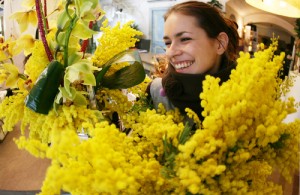 Today, March the 8th, is the International Women’s Day. Its historical roots draw backs to the beginning of the 20th century when it was called International Working Women’s Day. Now it is being celebrated, as each year, all the world round from different perspectives, ranging from a non-committal, vague respect, appreciation and love towards women to a more specific acknowledge of their economic political and social achievements.
Today, March the 8th, is the International Women’s Day. Its historical roots draw backs to the beginning of the 20th century when it was called International Working Women’s Day. Now it is being celebrated, as each year, all the world round from different perspectives, ranging from a non-committal, vague respect, appreciation and love towards women to a more specific acknowledge of their economic political and social achievements.
 Florence has chosen, on this day, a celebration far from ritual stereotypes, privileging human rights and cultural, political, social awareness, following the issues stated by United Nations. It is a day to be spent at theatres, at the museums. Most of cultural Florentine institutions are free for women, who can thus visit the Galleria degli Uffizi, the Cappelle Medicee, Palazzo Pitti, the Museo di San Marco and the Cappella Brancacci . The jewels of the town are open to their interests and passions, a considerable homage to the gender. Other interesting proposals by the local Confcommercio are tours dedicated to some famous Florentine women who indirectly shared with their husbands the government of the town, such as Eleonora of Toledo, wife of Cosimo the 1st Medicis, or Bianca Cappello , lover and later wife to Francesco of the Medici dynasty.
Florence has chosen, on this day, a celebration far from ritual stereotypes, privileging human rights and cultural, political, social awareness, following the issues stated by United Nations. It is a day to be spent at theatres, at the museums. Most of cultural Florentine institutions are free for women, who can thus visit the Galleria degli Uffizi, the Cappelle Medicee, Palazzo Pitti, the Museo di San Marco and the Cappella Brancacci . The jewels of the town are open to their interests and passions, a considerable homage to the gender. Other interesting proposals by the local Confcommercio are tours dedicated to some famous Florentine women who indirectly shared with their husbands the government of the town, such as Eleonora of Toledo, wife of Cosimo the 1st Medicis, or Bianca Cappello , lover and later wife to Francesco of the Medici dynasty.
 Other debates about women and fashion at Palazzo Pitti or women and power at Piazza della Repubblica or women and Middle ages at Piazza della Signoria.
Other debates about women and fashion at Palazzo Pitti or women and power at Piazza della Repubblica or women and Middle ages at Piazza della Signoria.
Libraries are, as well, centers of intellectual activities. In the Biblioteca Canova and at Villa Bandini there will be readings from Virginia Woolf, Sibilla Aleramo and Simone De Beauvoir, woman writers who have paved the way to many of everyday conquests. The whole town and surroundings are blossoming with initiatives: meetings, exhibitions, poetry readings.
The mimosa, up to now, symbol of the International Women’s Day, is no longer the only flower adorning the female gender. To oppose any kind of violence against women Antonio Marchese, famous rose hybridizer, has created a three-coloured rose to be planted in the Giardino delle Rose at Villa Bardini. The narcissus too, symbol of beauty and fertility in the Jewish tradition, has become another gender flower. An ideal overcoming of religious and cultural barriers in order to focus on the vital role women play in enhancing communities and countries, each according to their own skills and competences.


